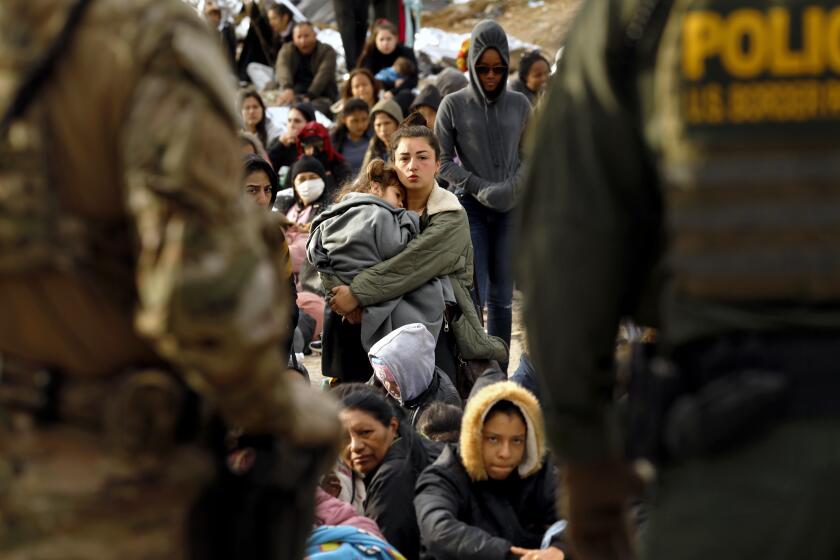Program to Fight Human Trafficking Is Underused
The single mother, struggling to support two children in Thailand, knew she couldn’t turn down a job offer as a cook in a Thai restaurant in Woodland Hills.
But when Thonglim Khamphiranon arrived at her new post, her boss -- described in government documents as the common-law wife of a Thai ambassador -- took away her passport, restricted her movements and forced her to work 17 hours a day, she said. She eventually escaped.
Based in part on her testimony, her boss, Supawan Veerapol, was convicted of involuntary servitude and harboring illegal immigrants. She was sentenced in 2000 to eight years in federal prison.
That’s how the T-visa program is supposed to work. Khamphiranon is one of what government officials believe are thousands of people lured into the United States each year to work as prostitutes or indentured servants. She has been able to stay here under the special visa created by Congress five years ago to encourage trafficking victims to come forward.
But the program appears to be significantly underused. There are 5,000 T-visas available each year, but fewer than 600 have been issued, with 111 others pending.
Officials acknowledge that there is no way to know for sure how many victims are out there. Exploited immigrants rarely report crimes, fearing reprisals against themselves or relatives in their home countries.
“There are probably a lot more cases than what we are seeing,” said Principal Deputy Assistant Atty. Gen. Bradley J. Schlozman. “But the true breadth of the problem is unknown.”
Authorities said a lack of public awareness and poor victim outreach efforts also may be contributing to the low number of T-visa recipients.
“We assumed that victims would in large numbers escape the situation that they were in and come forward,” said Wade Horn, an assistant secretary with the Department of Health and Human Services. “They didn’t do that.”
A UC Berkeley study earlier this year cited 57 cases of forced labor in California between 1998 and 2003. The majority of the victims were from Thailand and Mexico, forced to work as prostitutes, domestic slaves, farm laborers or sweatshop employees, according to the study.
Hoping to uncover more cases, federal authorities are taking a more active approach by forging partnerships with community organizations, setting up hotlines and training police officers, faith leaders and hospital workers to identify potential victims.
“If more cases aren’t discovered,” said Laura Lederer, senior advisor on trafficking for the U.S. State Department, “we will reassess.”
In Khamphiranon’s case, Veerapol promised her and other Thai women $240 a month to work at her restaurant, Gulf of Siam. She also offered them a free place to live.
“When I met her in Thailand, she painted such a pretty picture,” Khamphiranon said through an interpreter.
Khamphiranon said it didn’t take long to realize how miserable the situation was. She worked long hours every day at both the house and the restaurant, and Veerapol cut her pay to $140. She was forbidden to speak to customers, and she had to serve her boss on her knees. At night, she slept on the floor of Veerapol’s Woodland Hills home.
“She made it clear that she was the master and I was the servant,” Khamphiranon said.
Veerapol didn’t allow her to read Thai newspapers, go to temple or leave unaccompanied, Khamphiranon said. And she threatened Khamphiranon and her family back in Thailand if she tried to flee.
In 1998, Khamphiranon decided she had to take the risk. With the help of a sympathetic Thai family, she escaped and went to the Thai Community Development Center in Los Angeles. In exchange for her cooperation with law enforcement, she received a T-visa.
To qualify, visa applicants must be victims of a “severe form” of trafficking, face “extreme hardship” if they were to be deported and be willing to cooperate with reasonable requests from law enforcement in an investigation or prosecution. Those who receive T-visas can live and work in the U.S. for three years and can apply for permanent residency.
But advocates say the requirements for a T-visa are overly restrictive. Victims may not want to work with law enforcement because they are too traumatized, distrust police or fear deportation, they say.
“When they round up women and 50 get deported, that just sends a message to the whole community it’s a crapshoot,” said Norma Hotaling, founder of Standing Against Global Exploitation, which works with victims in the Bay Area.
As a result, some community-based organizations may not report cases that they know of to authorities.
Government officials said a victim’s willingness to work with law enforcement is essential to obtain a T-visa.
“If we are going to abolish modern-day slavery, then we have to put the traffickers out of business,” Horn said. “That’s going to demand, unfortunately, the cooperation of the victims.”
Because T-visa holders can apply to bring family members to the U.S., officials warn of the potential for fraud. In fact, about 550 T-visa applications have been denied.
“It comes down to documentation: Can they in fact prove they were trafficked, not just smuggled?” said Bill Strassberger, spokesman for U.S. Citizenship and Immigration Services, which issues the visas.
In one recent case, an investigation into South Korean prostitution rings in San Francisco and Los Angeles ended in more than 50 indictments this summer. Investigators believe that the women in Southern California were not forced to work as prostitutes.
“It’s just a matter of getting to the truth,” said Kevin Jeffery, deputy special agent in charge of Immigration and Customs Enforcement in Los Angeles. “A lot of times the truth isn’t what the public wants it to be. That’s the dilemma.”
It’s not easy to determine who is a trafficking victim, authorities said. Traffickers often coach victims on what to say, or frighten them into saying nothing.
“We have to convince these people we are on their side,” said Dina Romero, assistant special agent in charge at Immigration and Customs Enforcement.
That takes time and working closely with organizations such as the Coalition to Abolish Slavery and Trafficking, which provides shelter and social and legal services for victims in Los Angeles. Executive Director Kay Buck said victims are encouraged to go to police but are not pressured to do so.
“The ultimate decision rests with the client,” Buck said.
For law enforcement, uncovering trafficking cases remains the biggest challenge.
Sometimes victims cannot escape because they are kept in guarded compounds, such as in the case of 71 Thai workers freed from an El Monte sweatshop in 1995. But more often, threats and psychological coercion keep victims from leaving.
“In the rare case, the victims are chained by physical restraints,” said Assistant U.S. Atty. Caroline Wittcoff, who prosecutes trafficking cases in Los Angeles. “In trafficking cases, they are chained by their fear.”
Proving that victims were compelled to work by force, fraud or coercion can be difficult because there often are no eyewitnesses. The crimes are also hard to corroborate because they often occur behind locked doors -- in private homes, sweatshops or massage parlors.
Nevertheless, 382 suspects have been charged in trafficking cases nationwide since 1996, according to the U.S. Department of Justice. Since then, 248 people have been convicted.
Most of their victims are poor, uneducated and unable to speak English, authorities said.
“The victims are isolated,” said Rosa Fregoso, an attorney with the Legal Aid Foundation of Los Angeles who represented Khamphiranon. “Where are they going to find out about T-visas?”
No matter how isolated victims are, they often have some contact with the community. The new outreach efforts depend on that contact.
The Los Angeles Police Department recently received a $450,000 federal grant to train officers on how to identify potential victims and to set up a hotline and public service announcements. A special city commission is also heading an effort to educate building inspectors, firefighters, healthcare workers and other city employees, who may be the first people to encounter victims.
“They can be our eyes and ears,” said Paula Petrotta, executive director of the Commission on the Status of Women, which is working with the federal government on the public awareness campaign. More than 60 city department heads and staff attended the first training session at City Hall last week.
Authorities believe there are many undiscovered cases in Los Angeles, in part because of its proximity to the Mexican border. They also warn that immigrants voluntarily smuggled into the country run the risk of becoming victims of trafficking. Immigrants may agree to work as waitresses, officials said, but then be forced into prostitution. Or they may agree to a smuggling fee, only to discover the debt can never be repaid.
“It’s that deception, combined with the sort of general knowledge that there is better work elsewhere, that makes the victims very vulnerable,” said March Bell, senior special counsel for trafficking at the Department of Justice.
“The recruiter is often a world-class salesperson who gains complete trust.”
*
(BEGIN TEXT OF INFOBOX)
T-visa is rarely used
Victims of human trafficking are eligible for a special visa that allows them to live and work in the U.S. for three years and apply for permanent residency. There are 5,000 available each year, but only a small number have been issued.
*
T-visas issued
2002: 4
2003: 285
2004: 136
2005: 112
2006*: 34
Total: 571
Pending: 111
Denied: 550 (some applicants have been denied twice)
* As of Dec. 1
--
Sources: U.S. Citizenship and Immigration Services, U.S. Department of Justice
More to Read
Start your day right
Sign up for Essential California for news, features and recommendations from the L.A. Times and beyond in your inbox six days a week.
You may occasionally receive promotional content from the Los Angeles Times.






